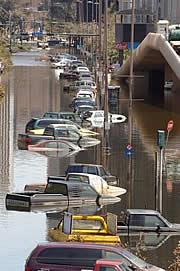 New Orleans drowned in petrol-contaminated water, but the pollution hasn't stuck.Abd Rabbo Ammar/ABACA/EMPICS
New Orleans drowned in petrol-contaminated water, but the pollution hasn't stuck.Abd Rabbo Ammar/ABACA/EMPICSNew Orleans' waters and soils seem to have survived the ravages of Hurricane Katrina without being contaminated by any toxic sludge.
The massive hurricane flooded the city in August last year with waters that were expected to be contaminated by sewage, petrol, and various household and industrial pollutants, from asbestos to pesticides. But just how toxic those floodwaters were, and what mess they might leave behind, wasn't known.
By October 2005, researchers from Lousiana State University had reported that the floodwaters themselves were not the 'toxic soup' feared, but instead looked much like the drainage you might expect in a city after heavy rain.1
This week, at a four-day session at the American Chemical Society meeting in San Francisco, California, scientist after scientist confirmed similar results: they have found no worrying or widespread elevated levels of pesticides, petroleum products or metals in the sediment. There was no significant effect on seafood, they say, or outbreaks of water-borne diseases.
Petroleum-based compounds are degrading quickly, they note, and there wasn't as much industrial pollution as feared as most of the water came from the relatively clean Lake Pontchartrain rather than the heavily industrialized Mississippi River.
"This concept of toxic soup simply wasn't so," says Chris Piehler, an environmental scientist with the Louisiana Department of Environmental Quality. Their exhaustive sampling of marine life in the area found a few localized fish kills, but nothing serious.
Fears quelled
Although the overall tone of meeting session was reassuring, there were some presentations that flagged up possible risks. A group from State University of New York, Stony Brook, found tiny particles of pyrite (a mineral often called fool's gold) in the city's sediments, probably washed in from the marshlands. These tiny flakes could theoretically damage lungs if inhaled, but there is no evidence that anyone has suffered so far.
ADVERTISEMENT
The US Environmental Protection Agency (EPA) has likewise concluded that "in general, the sediments left behind by the flooding from the hurricanes are not expected to cause adverse health impacts to individuals returning to New Orleans." They recommend, however, that homeowners till their soils and plant grass or flower beds on top to help stop material from blowing around.
The results don't necessarily mean that the city is clean; just that it isn't much dirtier than it was before the flood.
The EPA has found relatively high levels of lead, arsenic and diesel, plus a number of 'hotspots' of pollution in the area, sometimes near people's homes, says Gina Solomon of the Natural Resources Defense Council, a New York city-based environmental lobby. The metal contamination may pre-date the flood, and the diesel may be degrading quickly, but that doesn't mean it should be ignored, she says.
Visit our orleansclearedoftoxic_s.html">newsblog to read and post comments about this story.
